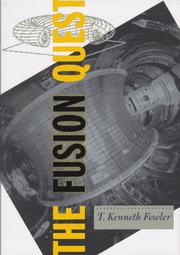| Listing 1 - 10 of 4574 | << page >> |
Sort by
|
Book
ISBN: 042440150X 1424401496 1509098852 Year: 2005 Publisher: Piscataway, New Jersey : Institute of Electrical and Electronics Engineers,
Abstract | Keywords | Export | Availability | Bookmark
 Loading...
Loading...Choose an application
- Reference Manager
- EndNote
- RefWorks (Direct export to RefWorks)
Book
Year: 1962 Publisher: Paris : Presses universitaires de France,
Abstract | Keywords | Export | Availability | Bookmark
 Loading...
Loading...Choose an application
- Reference Manager
- EndNote
- RefWorks (Direct export to RefWorks)
Periodical
Abstract | Keywords | Export | Availability | Bookmark
 Loading...
Loading...Choose an application
- Reference Manager
- EndNote
- RefWorks (Direct export to RefWorks)
Book
Abstract | Keywords | Export | Availability | Bookmark
 Loading...
Loading...Choose an application
- Reference Manager
- EndNote
- RefWorks (Direct export to RefWorks)
Fusion power may offer a long-term energy supply with an uninterrupted power delivery, a high power-generation density, and no greenhouse gas emissions, contributing to preventing the worst effects of climate change and making an enduring contribution to future energy supply. However, the intense conditions inside a fusion power plant (extreme temperatures and high magnetic fields necessary for nuclear fusion) call for addressing several potential problems. These include the development of new materials with extremely high heat tolerances and low enough vapor pressure and the design of mechanical structures that can withstand the electromagnetic force generated as well as feedback controllers to measure and counteract the unstable modes of evolution of the plasma, to name a few. The future of nuclear fusion as an efficient alternative energy source depends largely on techniques that enable us to control these instabilities. Mathematical modelling and physical experiments attempt to overcome some of the hindrances posed by these complexities. This book provides a comprehensive overview of the current state of the art in this fascinating and critically important field of pure and applied physics, mathematics, and engineering, presenting some of the most recent developments in theory, modelling, algorithms, experiments, and applications.
Book
Abstract | Keywords | Export | Availability | Bookmark
 Loading...
Loading...Choose an application
- Reference Manager
- EndNote
- RefWorks (Direct export to RefWorks)
Fusion power may offer a long-term energy supply with an uninterrupted power delivery, a high power-generation density, and no greenhouse gas emissions, contributing to preventing the worst effects of climate change and making an enduring contribution to future energy supply. However, the intense conditions inside a fusion power plant (extreme temperatures and high magnetic fields necessary for nuclear fusion) call for addressing several potential problems. These include the development of new materials with extremely high heat tolerances and low enough vapor pressure and the design of mechanical structures that can withstand the electromagnetic force generated as well as feedback controllers to measure and counteract the unstable modes of evolution of the plasma, to name a few. The future of nuclear fusion as an efficient alternative energy source depends largely on techniques that enable us to control these instabilities. Mathematical modelling and physical experiments attempt to overcome some of the hindrances posed by these complexities. This book provides a comprehensive overview of the current state of the art in this fascinating and critically important field of pure and applied physics, mathematics, and engineering, presenting some of the most recent developments in theory, modelling, algorithms, experiments, and applications.
Periodical
Year: 1984 Publisher: La Grange Park, Ill. : American Nuclear Society,
Abstract | Keywords | Export | Availability | Bookmark
 Loading...
Loading...Choose an application
- Reference Manager
- EndNote
- RefWorks (Direct export to RefWorks)

ISBN: 0801854563 Year: 1997 Publisher: Baltimore, MD London Johns Hopkins University Press
Abstract | Keywords | Export | Availability | Bookmark
 Loading...
Loading...Choose an application
- Reference Manager
- EndNote
- RefWorks (Direct export to RefWorks)
Book
Abstract | Keywords | Export | Availability | Bookmark
 Loading...
Loading...Choose an application
- Reference Manager
- EndNote
- RefWorks (Direct export to RefWorks)
The multistage depressed collector (MDC) shall be one of the key technologies to achieve the required gyrotron efficiency in the DEMOnstration fusion power plant. For the first time, this work presents a comprehensive study of possible gyrotron MDC concepts. Concepts, only using axisymmetric E- and B-field components are shown to be insufficient. Instead, promising concepts using the E×B drift are proposed. A detailed study of a novel MDC concept using an azimuthal electric field is presented.
Book
Year: 2014 Publisher: Hannover : KIT Scientific Publishing,
Abstract | Keywords | Export | Availability | Bookmark
 Loading...
Loading...Choose an application
- Reference Manager
- EndNote
- RefWorks (Direct export to RefWorks)
The 17th International Workshop on Ceramic Breeder Blanket Interaction was held in Barcelona, Spain, on September, 12-14, 2013, as a satellite meeting of the 11th International Symposium on Fusion Nuclear Technology (ISFNT-11). The CBBI-17 provided a forum of specialists involved in the design, research, development and testing of materials and components for lithium ceramic based breeding blankets. The proceedings summarize the presentations and the topical discussions of the workshop.
Book
Year: 2015 Publisher: Karlsruhe : KIT Scientific Publishing,
Abstract | Keywords | Export | Availability | Bookmark
 Loading...
Loading...Choose an application
- Reference Manager
- EndNote
- RefWorks (Direct export to RefWorks)
The Karlsruhe Institute of Technology (KIT) is working in the framework of the European Fusion Programme on key technologies in the areas of superconducting magnets, microwave heating systems (Electron-Cyclotron-Resonance-Heating, ECRH), the deuterium-tritium fuel cycle, He-cooled breeding blankets, a He-cooled divertor and structural materials, as well as refractory metals for high heat flux applications including a major participation in the preparation of the international IFMIF project.
| Listing 1 - 10 of 4574 | << page >> |
Sort by
|

 Search
Search Feedback
Feedback About UniCat
About UniCat  Help
Help News
News